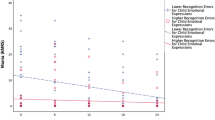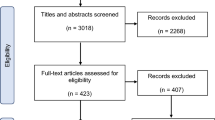Abstract
In non-clinical community samples, older adults are less accurate at identifying others’ emotional expressions than younger adults. Less is known about the effects of age on facial emotion recognition (ER) in clinical samples. We explored ER in outpatients presenting for assessment/treatment of emotional disorders. We predicted that depression severity would be associated with slower, less accurate ER. We expected to find an effect for age, with younger adults showing superior ER performance for negative emotions (fear, anger, sadness). 644 outpatients (57.6% female, M age 31.31, range = 18–76) completed an ER task and a self-report measure of depression severity, the Beck Depression Inventory (BDI-II). The BDI-II was rescored (BDI-R), using only the 10 items specific to unipolar depression, as determined by factor analysis. 34.6% of participants had a clinical depressive disorder. All other participants had a clinical anxiety disorder or not otherwise specified mood disorder. Depression severity, based on the BDI-R, did not predict ER accuracy or intensity for any face type. Age was associated with lower ER accuracy and higher intensity scores for sad and fearful faces, and lower overall accuracy of ER. In a large, transdiagnostic clinical sample of adults with emotional disorders, we found a decline in ER performance with age, particularly for negative emotions (sadness, fear). There was no significant association between depression and ER in our sample, suggesting the importance of considering additional variables such as state affect, attention, and arousal.



Similar content being viewed by others
References
Beck, A. T., Steer, R. A., & Brown, G. K. (1996). Manual for the Beck depression inventory-II. San Antonio: Psychological Corporation.
Berg, H. E., Ballard, E. D., Luckenbaugh, D. A., Nugent, A. C., Ionescu, D. F., & Zarate, C. A. (2016). Recognition of emotional facial expressions in anxious and nonanxious depression. Comprehensive Psychiatry, 70, 1–8. https://doi.org/10.1016/j.comppsych.2016.06.007.
Bourke, C., Douglas, K., & Porter, R. (2010). Processing of facial emotion expression in major depression: A review. Australian and New Zealand Journal of Psychiatry, 44, 681–696. https://doi.org/10.3109/00048674.2010.496359.
Brown, T. A., & Barlow, D. H. (2014). Anxiety and related disorders interview schedule for DSM-5 – Adult and lifetime version: Clinician manual. New York: Oxford University Press.
Brown, T. A., Chorpita, B. F., & Barlow, D. H. (1998). Structural relationships among dimensions of the DSM-IV anxiety and mood disorders and dimensions of negative affect, positive affect, and autonomic arousal. Journal of Abnormal Psychology, 107, 179–192.
Brown, T. A., Di Nardo, P. A., Lehman, C. L., & Campbell, L. A. (2001). Reliability of DSM-IV anxiety and mood disorders: Implications for the classification of emotional disorders. Journal of Abnormal Psychology, 110, 49–58.
Carstensen, L. L. (1992). Social and emotional patterns in adulthood: Support for socioemotional selectivity theory. Psychology and Aging, 7(3), 331–338.
Carstensen, L. L., Isaacowitz, D. M., & Charles, S. T. (1999). Taking time seriously: A theory of socioemotional selectivity. American Psychologist, 54(3), 165–181.
Carton, J. S., Kessler, E. A., & Pape, C. L. (1999). Nonverbal decoding skills and relationship well-being in adults. Journal of Nonverbal Behavior, 23, 91–100.
Cohen, J. (1988). Statistical power analysis for the behavioral sciences. Hillside, NJ: Erlbaum.
Cohen, J. (1992). A power primer. Psychological Bulletin, 112(1), 155–159.
Dalili, M. N., Penton-Voak, I. S., Harmer, C. J., & Munafò, M. R. (2015). Meta-analysis of emotion recognition deficits in major depressive disorder. Psychological Medicine, 45(6), 1135–1144. https://doi.org/10.1017/S0033291714002591.
Ekman, P., & Friesen, W. V. (1976a). Measuring facial movement. Environmental Psychology and Nonverbal Behavior, 1, 56–75.
Ekman, P., & Friesen, W. V. (1976b). Pictures of facial affect. Palo Alto: Consulting Psychologists Press.
Fieker, M., Moritz, S., Köther, U., & Jelinek, L. (2016). Emotion recognition in depression: An investigation of performance and response confidence in adult female patients with depression. Psychiatry Research, 242, 226–232. https://doi.org/10.1016/j.psychres.2016.05.037.
Gollan, J. K., Pane, H. T., McCloskey, M. S., & Cooccaro, E. F. (2008). Identifying differences in biased affective information processing in major depression. Psychiatry Research, 159, 18–24. https://doi.org/10.1016/j.psychres.2007.06.011.
Isaacowitz, D. M., Lockenhoff, C. E., Lane, R. D., Wright, R., Sechrest, L., Riedel, R., & Costa, P. T. (2007). Age differences in recognition of emotion in lexical stimuli and facial expressions. Psychology and Aging, 22, 147–159. https://doi.org/10.1037/0021-843X.115.4.705.
Joormann, J., & Gotlib, I. H. (2006). Is this happiness I see?: Biases in the identification of emotional facial expressions in depression and social phobia. Journal of Abnormal Psychology, 115, 705–714.
Leppänen, J., Milders, M., Bell, S. J., Terriere, E., & Hietanen, J. K. (2004). Depression biases in the recognition of emotionally neutral faces. Psychiatry Research, 128, 123–133.
Liu, W. -H., Huang, J., Wang, L. -Z., Gong, Q., & Chan, R. C. K. (2012). Facial perception bias in patients with major depression. Psychiatry Research, 197, 217–220. https://doi.org/10.1016/j.psychres.2011.09.021.
Mezuk, B., & Kendler, K. S. (2012). Examining variation in depressive symptoms over the life course: A latent class analysis. Psychological Medicine, 42, 2037–2046. https://doi.org/10.1017/S003329171200027X.
Mill, A., Allik, J., Realo, A., & Valk, R. (2009). Age-related differences in emotion recognition ability: A cross-sectional study. Emotion, 9, 619–630. https://doi.org/10.1037/a0016562.
Richter, D., Dietzel, C., & Kunzmann, U. (2011). Age differences in emotion recognition: The task matters. The Journals of Gerontology: Series B, Psychological Sciences And Social Sciences, 66B(1), 48–55. https://doi.org/10.1093/geronb/gbq068.
Ruffman, T., Henry, J. D., Livingstone, V., & Phillips, L. H. (2008). A meta-analytic review of emotion recognition and aging: Implications for neuropsychological models of aging. Neuroscience and Biobehavioral Reviews, 32, 863–881.
Salthouse, T. A. (1996). The processing-speed theory of adult age differences in cognition. Psychological Review, 103(3), 403–428.
Shiroma, P. R., Thuras, P., Johns, B., & Lim, K. O. (2014). Emotion recognition processing as early predictor of response to 8-week citalopram treatment in late-life depression. International Journal of Geriatric Psychiatry, 29, 1132–1139. https://doi.org/10.1002/gps.4104.
Shiroma, P. R., Thuras, P., Johns, B., & Lim, K. O. (2016). Facial recognition of happiness among older adults with active and remitted depression. Psychiatry Research, 243, 287–291. https://doi.org/10.1016/j.psychres.2016.06.020.
Steer, R. A., Ball, R., Ranieri, W. F., & Beck, A. T. (1997). Further evidence for the construct validity of the Beck depression inventory- II with psychiatric outpatients. Psychological Reports, 80, 443–446.
Sullivan, S., & Ruffman, T. (2004). Emotion recognition deficits in the elderly. International Journal of Neuroscience, 114(3), 403–432. https://doi.org/10.1080/00207450490270901.
Venn, H. R., Watson, S., Gallagher, P., & Young, A. H. (2006). Facial expression perception: An objective outcome measure for treatment studies in mood disorders? International Journal of Neuropsychopharmacology, 9, 229–245. https://doi.org/10.1017/S1461145705006012.
Yoon, K. L., Joormann, J., & Gotlib, I. H. (2009). Judging the intensity of facial expressions of emotion: Depression-related biases in the processing of positive affect. Journal of Abnormal Psychology, 118, 223–228. https://doi.org/10.1037/a0014658.
Acknowledgments
The authors thank Alice Cronin-Golomb, Kristin Long, and Bonnie Brown for their assistance with this study.
Funding
This work was supported by the National Institute of Mental Health (grant number MH039096 to T.A.B.); and the Boston University Clara Mayo Fellowship (to L.A.R.).
Author information
Authors and Affiliations
Corresponding author
Ethics declarations
Conflict of Interest
Lauren A. Rutter, Daniel J. Norton and Timothy A. Brown have no conflicts of interest or disclosures to report.
Experiment Participants
All procedures performed in studies involving human participants were in accordance with the ethical standards of the institutional and/or national research committee and with the 1964 Helsinki declaration and its later amendments or comparable ethical standards.
Informed Consent
Informed consent was obtained from all individual participants included in the study.
Additional information
Publisher’s Note
Springer Nature remains neutral with regard to jurisdictional claims in published maps and institutional affiliations.
Rights and permissions
About this article
Cite this article
Rutter, L.A., Norton, D.J. & Brown, T.A. The Impact of Self-Reported Depression Severity and Age on Facial Emotion Recognition in Outpatients with Anxiety and Mood Disorders. J Psychopathol Behav Assess 42, 86–92 (2020). https://doi.org/10.1007/s10862-019-09755-w
Published:
Issue Date:
DOI: https://doi.org/10.1007/s10862-019-09755-w




